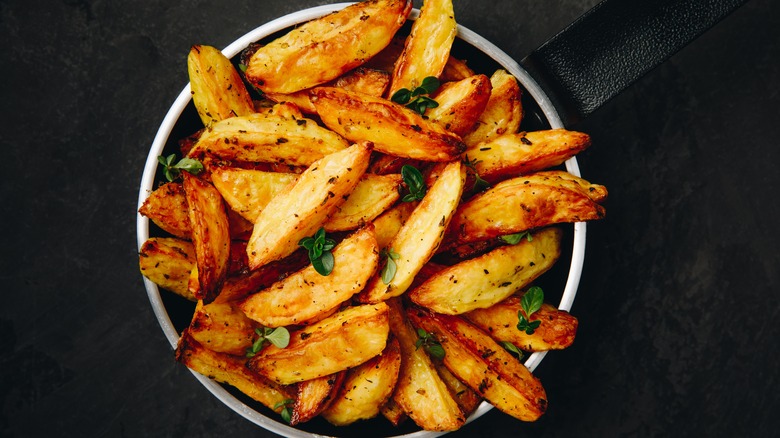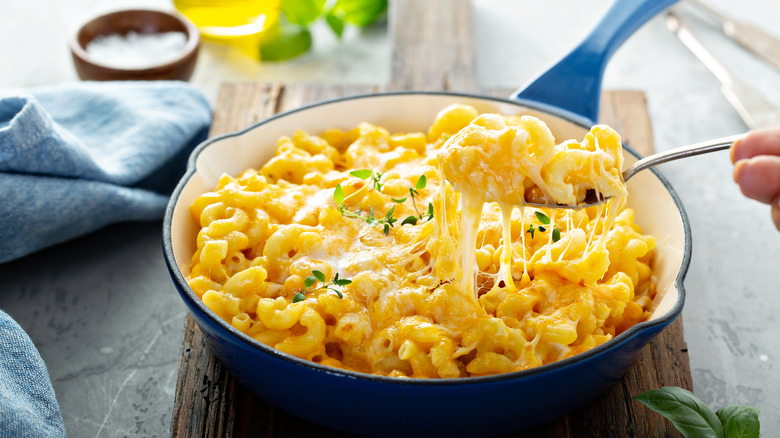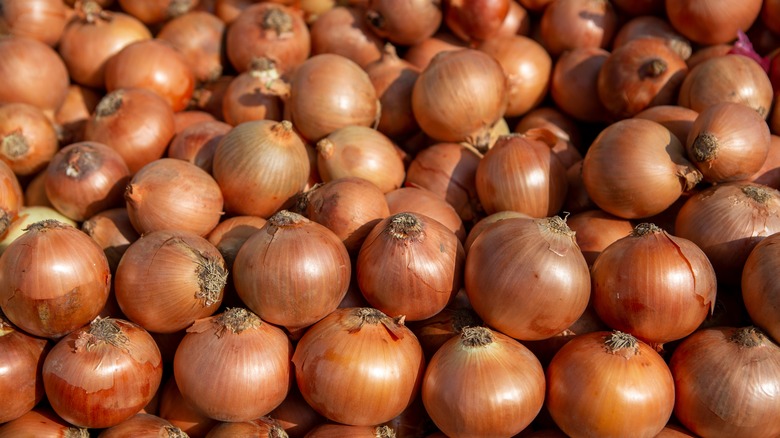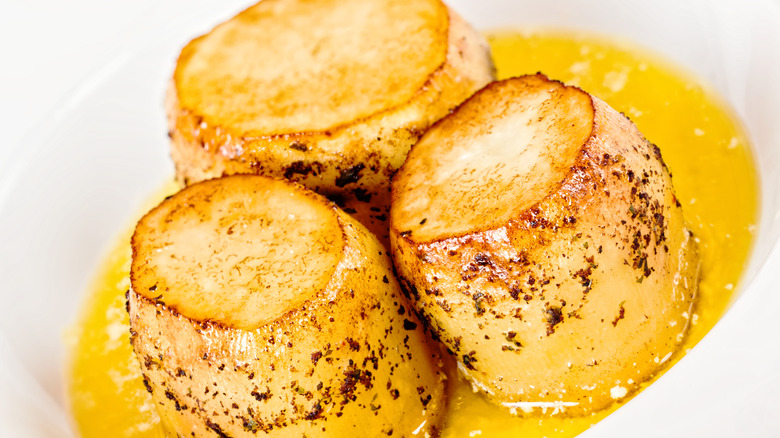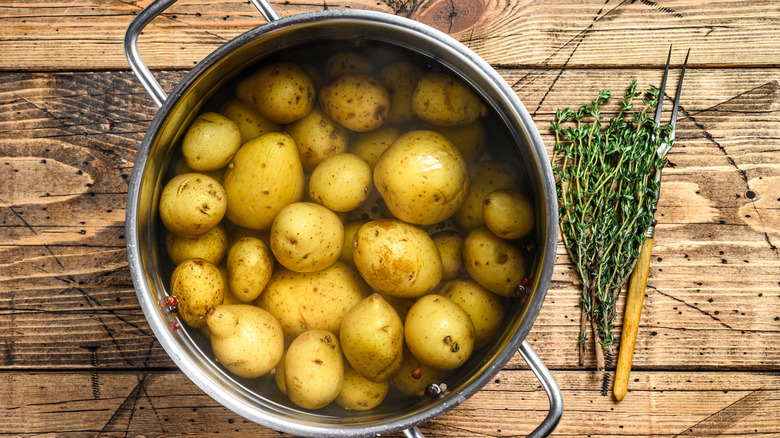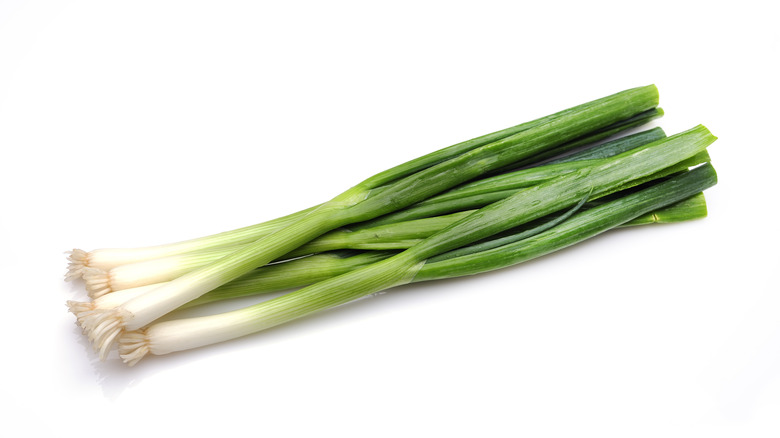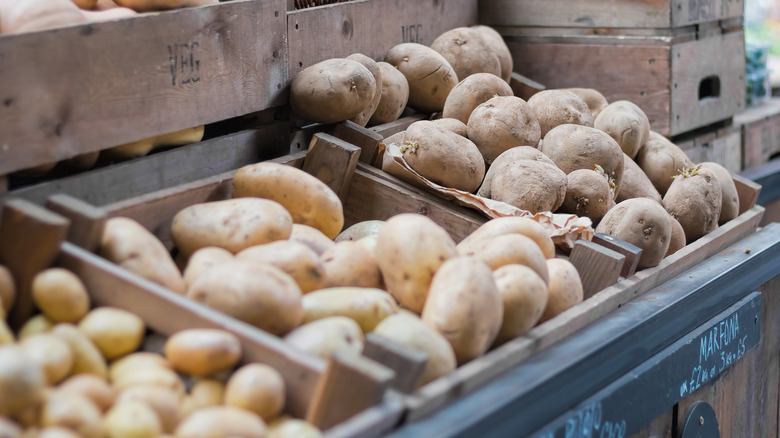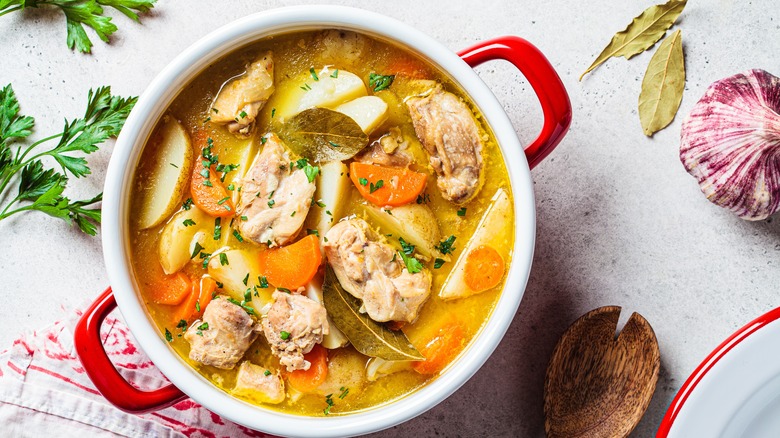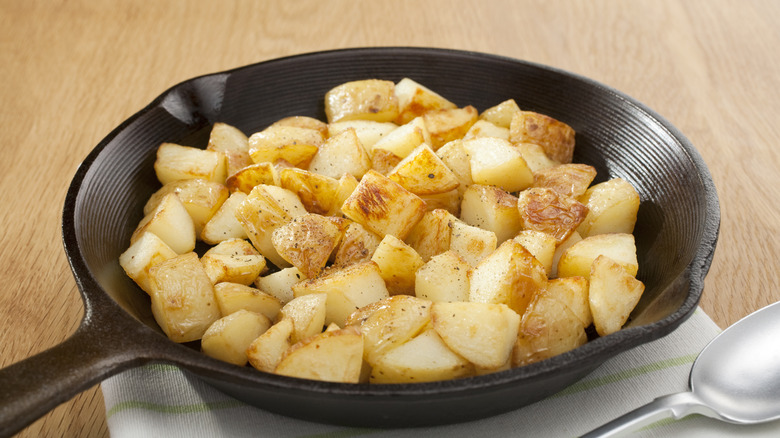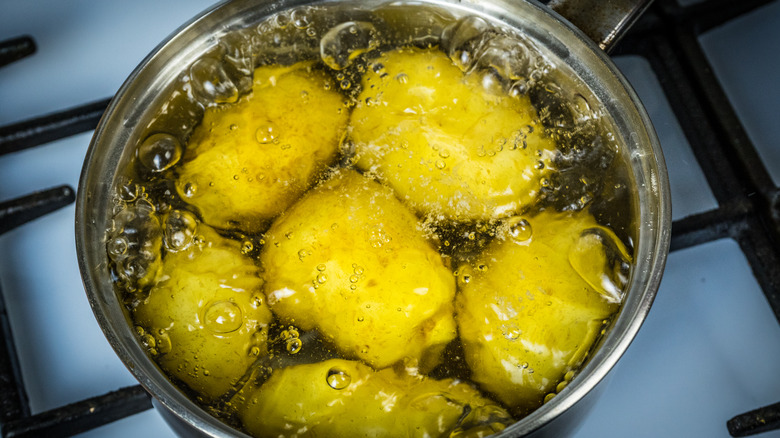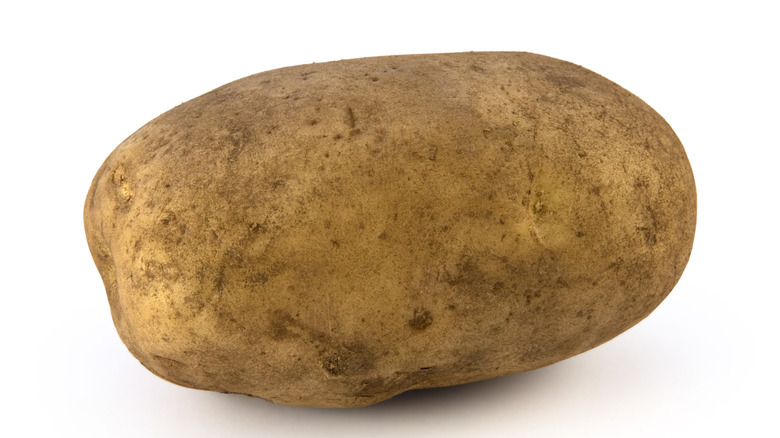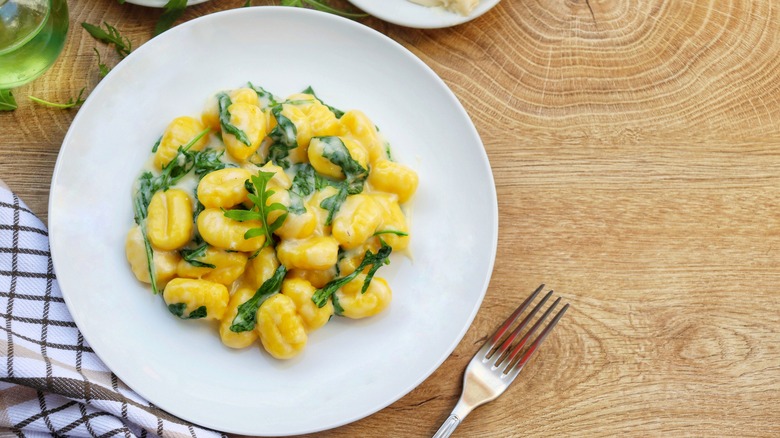Gordon Ramsay's 11 Best Tips For Cooking Potatoes
Gordon Ramsay may have garnered a number of Michelin stars in his years as a chef, made a name for himself over his meticulous attention to detail in his shows, and generally continued to succeed in his career by opening one high-end restaurant after another, but his down-home cooking tips are nevertheless accessible to almost any home chef, amateur or otherwise. For these, he uses ingredients we all recognize, in most cases, and putting them together doesn't require a stint at the CIA. If you've ever seen any of his YouTube videos, you'll notice how approachable Gordon Ramsay seems, despite his "Kitchen Nightmares" reputation, and how willing and eager he is to explain every tip and trick he pulls out of his sleeve.
One video we found particularly impressive was his guide to potatoes, which explains in detail how to choose from the wide range of potatoes that are available on the market. It really shows how important it is to choose the right potato for a particular recipe, especially if you want it to turn out just right. For instance, the best type of potato to bake might not be the ideal one for a mashed dish. But Gordon Ramsay has a whole treasure trove of advice on cooking with potatoes, whether mashed, roasted, sautéed, or otherwise, so we thought we'd delve into some of his best pointers and see how we might apply them.
Top your baked potato with mac and cheese
If you're looking for a comforting meal on a cool fall afternoon, you could do a lot worse than a baked potato topped with mac and cheese, as Gordon Ramsay suggests. Although he initially conceived of this recipe as a St. Patrick's Day snack, it can be used for any event, special or otherwise.
First of all, it's incredibly tasty, comforting, and filling. And second, it's easy to make. All you have to do is bake a potato and fill it with chives and chili before topping it with mac and cheese, as literally as it sounds. Just be sure to follow the rules for delicious baked potatoes, which include thoroughly drying the potatoes and poking their skin before putting them in the oven. Meanwhile, prepare any chili of your choice, such as this classic Cincinnati chili, and then top it all off with a simple mac and cheese, which should only take you about 10 minutes to put together. Finally, make sure your mac and cheese is covered with a good helping of breadcrumbs so that when you put the whole shebang back in the oven, it comes out with a nice golden top. Gordon Ramsay may not tell you this, but if you're looking to offset the creaminess of this hefty dish, you can serve it with a simple salad tossed with a light vinaigrette.
Grate raw onion along with your potatoes when making hash browns
It's hard to go wrong with hash browns, which are essentially fried shredded potatoes. But there are many ways to make them even better, and Gordon Ramsay, for one, suggests making hash browns by grating some onion along with the potatoes. Just make sure you don't skip the step that gets rid of much of the moisture, as any mixture containing onion is going to be a bit wetter than potato alone. To that end, salt your grated mixture, put it in a strainer, and try to squeeze out as much liquid as you can. Dried ingredients will help yield a crispier result.
Speaking of crispy, another way to achieve this is to pick the right potato. Any type of waxy potato will do, according to Ramsay, because they hold together throughout the cooking process. This is especially important if you want to follow his next tip, which is to crack a few eggs right onto the hash brown patty and bake everything in the oven together. This step involves making sure your potatoes are packed tightly into the pan and cooked evenly by pressing them down around the edges. Then simply flip the potatoes, cook them briefly on the other side, and break the eggs over them, using them as a base. Pair this dish with crispy bacon and your favorite breakfast accouterments.
Pick a robust specimen for fondant potatoes
Gordon Ramsay can show us how to prepare all sorts of plebeian dishes for poor souls who barely know how to crack an egg, but let's not forget that his training is in high-end French cooking, and Ramsay's fondant potatoes are here to remind us of this. This recipe involves a bit of frying, a bit of baking, and a fair amount of attention to detail, so any tips he might have for making this dish a bit easier to prepare are more than welcome as far as we're concerned.
Luckily, the key to a good fondant potato recipe is simply to use the right kind of potato. Because this recipe does involve a number of steps, it's going to need a robust potato that can withstand all the to and fro. But Ramsay doesn't leave us high and dry with just that. He also suggests halving the potato after peeling it, instead of just cutting off the top and bottom. This will maximize the surface area exposed to cooking elements like butter and broth, intensifying the flavor of the potatoes and deepening the caramelization effect. Aside from these little twists, you can follow any fondant potato recipe of your choice. Ours calls for you to brown the potatoes in a pan after preparing them, along with butter, rosemary, thyme, garlic, salt, and pepper. After this, coat the potatoes in chicken broth and bake them for one hour at 350 degrees Fahrenheit.
Parboil potatoes and top them with flour before roasting them
Roasted potatoes are one of the easiest dishes. You just dice some potatoes, toss them in olive oil and seasoning, and then throw them in the oven for a half hour or more. Right? Maybe not. Actually, according to Gordon Ramsay and many other quality chefs, parboiling the potatoes before you bake them is a small step that can make a big difference. Adding the potatoes to boiling water can, in fact, help release the starches in potatoes that are responsible for making them turn crispy once they're in the oven. But don't worry. This isn't going to add much time or effort to your easy potato dinner. You'll just have to boil the potatoes for only about 10 to 15 minutes, or until you can easily poke through them with a fork, then proceed with the baking as usual. And for even more crispiness, Ramsay suggests sprinkling the potatoes with a bit of flour right before putting them in the oven.
You can test out these theories with your own favorite recipe. We like this lemony rotated potatoes recipe, which calls for mixing lemon juice with olive oil, lemon zest, oregano, basil, onion powder, parsley, pepper, thyme, cinnamon, nutmeg, salt, and minced garlic and coating the potato wedges with this mixture. Then place the wedges on a baking sheet with the skin-side down and add a few dollops of butter. Roast these for one hour at 350 degrees Fahrenheit.
Add green onions to your mashed potatoes
Mashed potatoes are rich, creamy, and delicious, but let's face it — they can look a bit drab. Not so with Ramsay's trick of adding green onions, which adds both flavor and color to the dish. Just beware that the onions are raw, meaning pungent and slightly bitter, so if you tend to shy away from these flavors, don't add a whole bunch of onions, as Ramsay does, or opt for the milder chive instead.
To execute this fun piece of advice, you can use pretty much any mashed potato recipe, like for these creamy Instant Pot mashed potatoes. Here you'll have to peel and dice your potatoes before placing them in the vessel with its steamer basket. Cook the potatoes for eight minutes, then mash them together with chicken broth, butter, Parmesan cheese, sour cream, mayonnaise, salt, and garlic granules. At this point it is safe to add the pop of color and flavor: simply stir in your green onions (or chives) to create the final product. And if you don't have an Instant Pot, don't worry. There are plenty of other ways to make simple mashed potatoes, including by boiling them on the stove and then running them through a ricer or even mashing them in a standing mixer.
Reach for Jersey Royal potatoes first
Gordon Ramsay knows a lot about cooking, which includes knowing a lot about potatoes, their different varieties, and how they behave in the cooking process. With all that knowledge, he has come up with the perfect potato for salads, boiling, or pretty much anything, and that is the Jersey Royal potato, an early crop type of new potato that you should always have on hand if you have potatoes at all. In a recent YouTube video, Ramsay explained that this is his favorite potato because of its "delicate sweet flavor, it's packed with vitamin C, and is great in salads or simply boiled and mixed with olive oil and fresh mint."
Jersey Royals are best enjoyed with the skin on. They just need to be washed and boiled and then used in a great potato salad. We recommend this dill potato salad recipe because it's easy to make without skimping on flavor. Start by cleaning the potatoes and boiling them for about 20 minutes before letting them cool a bit and dicing them up. Then simply coat them in a mixture of mayonnaise, finely chopped onion, Dijon mustard, olive oil, minced garlic, lemon juice, dill, salt, and pepper.
Use Charlotte potatoes for stews or roast chicken
Gordon Ramsay has made no secret of his preference for Charlotte potatoes among main crop waxy potatoes, which tend to retain their shape more than floury potatoes. For this reason, Charlotte and other waxy potatoes are ideal for stews or as accompaniments to stews, as they won't fall apart even as they reach leftover status.
An example of this effect can be seen in action during the preparation of our old-fashioned beef stew. This is a fairly involved recipe with a lot of steps, but it's worth the effort, as the stew will yield plenty of portions and last for days, becoming more flavorful with each passing hour. To make it, you'll need to cook some flour-dusted beef chuck cubes with onions, garlic, and bacon in several stages, with the peeled and diced potatoes entering along with the carrots after the stew has had about 1 ½ hours to simmer. Cook for another 30 minutes until the potatoes are tender before adding one last hurrah of seasoning and serving hot with fresh thyme as a garnish. Another great way to use these potatoes is in this aloo curry recipe, where the potatoes are added to a fragrant pot of oil, cumin seeds, onion, garlic, and chile pepper along with curry powder, salt, pepper, and turmeric. Once the potatoes are evenly coated, add vegetable broth and cook for about 25 minutes, until the potatoes are tender but still fully intact.
Leave the skin on when making sauté potatoes
Sauté potatoes, or as Gordon Ramsay calls them in his YouTube video, a "posh chip," are, indeed, a fancy but easy fried potato. To make the most of it, Ramsay suggests leaving the potato skins on, to make sure the tubers don't fall apart during cooking. So all you have to do is clean the potatoes and slice them in half before parboiling them in salted water. Cook them for four to five minutes with the lid on until softened, then place them cut-side down on a very hot pan. Add salt, pepper, garlic, and chopped rosemary and sauté until done.
Leaving the skin on is a great trick for other recipes too, as long as you care about keeping the potato intact, and you're not intending to mash it, for example. Any roasted potato recipe can benefit from keeping the skin on, for instance, as in this tasty Greek lemon potatoes recipe, which requires you to spread potato wedges on a baking pan and top them with a mixture of lemon juice, olive oil, chicken broth, salt, and oregano. Bake, covered in foil, for 50 minutes at 400 degrees Fahrenheit, then remove the foil and bake for another 30 minutes.
Always start with cold water to boil potatoes
If you've ever boiled potatoes just to see them collapse on the outside before being cooked in the middle, you'll find this tip particularly helpful. According to Gordon Ramsay, in fact, it's best to always start boiling your potatoes from cold water, rather than tossing them into a pot of already boiling water. As he says on his YouTube channel, "This way, by the time the centers of the potatoes are cooked, the outside won't be falling apart."
Following this rule is especially important when the potatoes are the star of the show, like in this salt-crusted potato recipe, which literally involves nothing more than potatoes, salt, and water. To prepare this correctly, it's important to get over any fears of using too much salt, as you are required to add anything from 1 tablespoon of salt per pound of potatoes to 2 cups of salt per 4 pounds of potatoes. The salt should be added to the water in which the potatoes are boiling, which is just enough to cover the potatoes. You will then boil the water down until it has completely disappeared, whereupon the piles of salt you added should crystallize on the skins of the potatoes, creating an extremely salty exterior that will contrast nicely with the saltless, fluffy interior.
Select floury potatoes when mashing, roasting, or making fries
If you're looking for a fluffy, dry texture in a potato, especially for mashed, roasted, or fried potatoes, Gordon Ramsay suggests you opt for a floury type of potato like a King Edward, with a smooth, creamy flesh, a Desiree, which comes with red skin, or a Heritage potato, which comes in several different colors, just for fun.
This tip in particular is a great opportunity to step back and really take notice of the differences between waxy and starchy, or floury, potatoes. The former tends to retain its shape more easily, making it the perfect choice for salads or stews. The latter has a low moisture content and is dominated by the Russet potato, one of the most popular in America. This quality makes it ideal for mashed potatoes, for one, as it quickly dissolves into a creamy substance that makes a fine home for sauces like gravy, which it absorbs wholeheartedly. Likewise, roasted and fried potatoes made with a floury variety will expertly take on the flavor of whichever fat you choose to douse them with.
Apply leftover baked or boiled potatoes to a quick gnocchi recipe
A great general tip that Gordon Ramsay has to offer is to always cook extra potatoes whenever you embark on a potato recipe. But what to do with those leftovers? He has plenty of suggestions, foremost of which is a quick gnocchi recipe he makes on his YouTube channel in hardly any time at all.
You, too, can start this endeavor by grabbing two leftover baked or boiled potatoes, scooping out their fluffy insides, and mashing them with a fork or passing them through a ricer. Then add a dollop of ricotta, which is not traditional for gnocchi but it certainly won't hurt, and then season with salt and pepper, which you must do throughout the recipe to make sure the flavor of the potatoes is brought out to the max. Add some flour, maybe a bit of thyme, make a well in the center of your pile of ingredients, and pour in a whisked egg before you start to knead the mixture, combining it until smooth. At this point, you can continue with any other gnocchi recipe. Roll the dough into tubes, slice them up into 1-inch pieces, and toss the gnocchi into a pot of boiling water until they float to the surface. Finish them off by frying them in olive oil.
